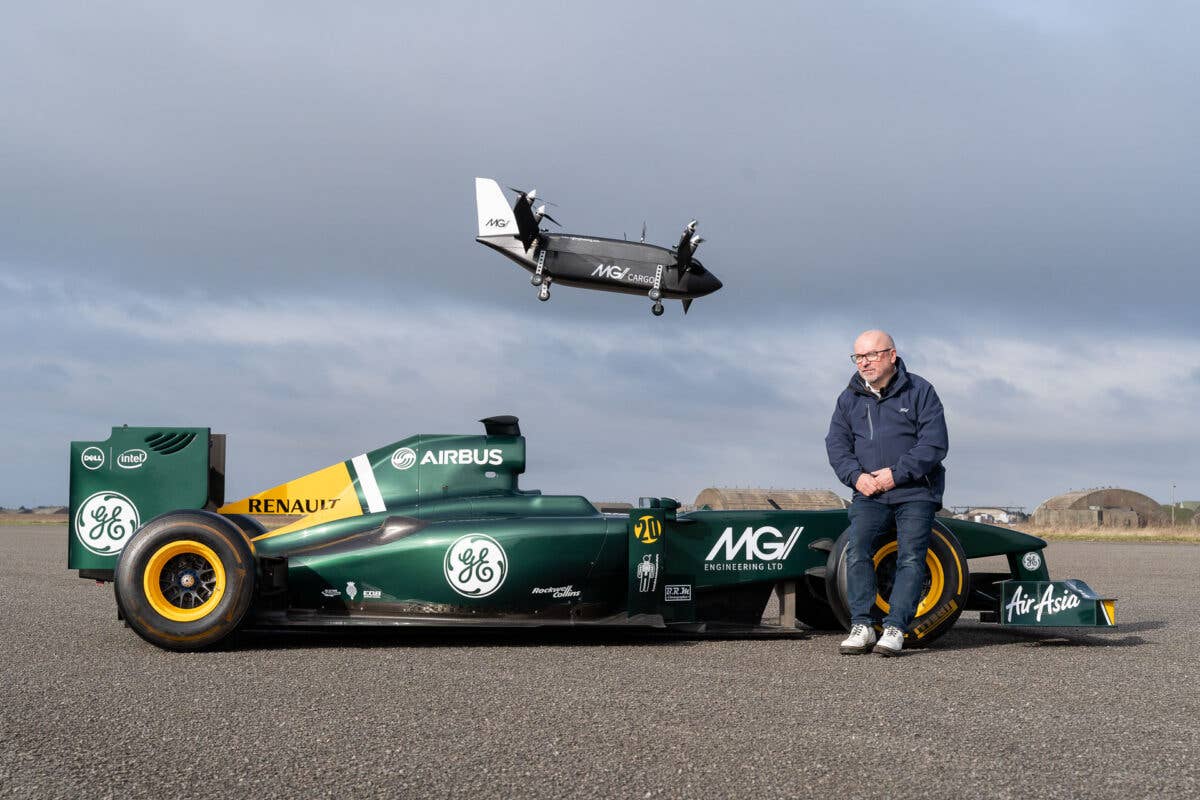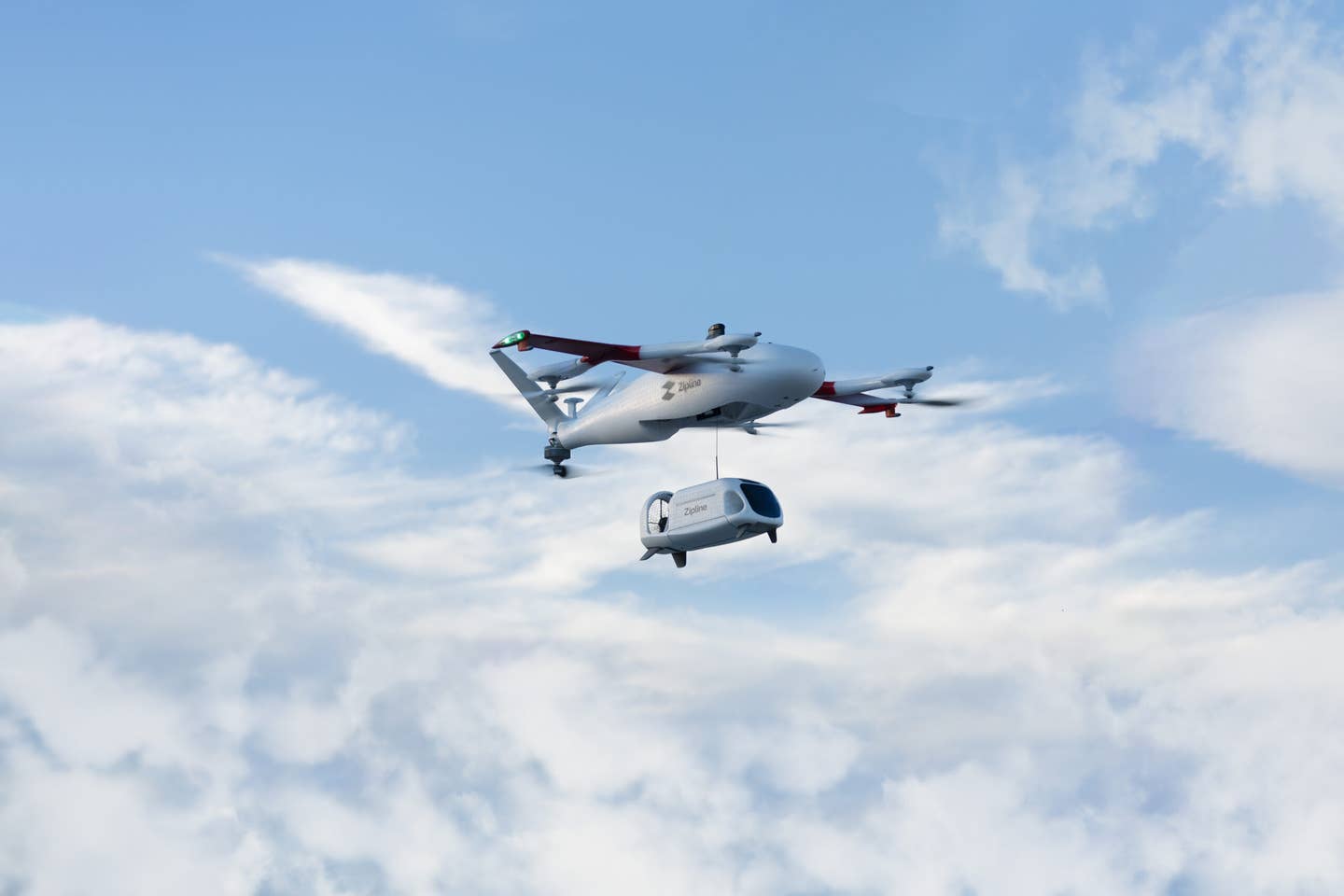F1 Engineering Gives Lift to Cargo eVTOL Drone Design
MGI Engineering, a maker of motorsport technology, just unveiled its cargo drone demonstrator—here’s what the CEO had to say.

Mike Gascoyne, founder and CEO of MGI Engineering, in front of the company’s eVTOL cargo drone demonstrator and an F1 car. [Courtesy: MGI Engineering]
Mike Gascoyne has climbed the Himalayas. He’s completed a 3,200-mile crossing of the Atlantic by himself. He’s spent over 25 years at the senior technical management level in Formula 1, working for teams around the world. But Gascoyne’s next challenge might be his biggest.
MGI Engineering, founded by Gascoyne in 2003, has served the motorsport industry for decades now—and even launched its own F1 team, Caterham. Now, the firm is pivoting to a new focus: aerospace, specifically electric vertical takeoff and landing (eVTOL) cargo drones.
“I come from one of the most challenging [industries] in F1,” Gascoyne, a world-renowned F1 engineer, told FLYING. “So I think that’s what I actually like, is that having come from F1, it's coming into something that's equally challenging.”
The challenge of working in the nascent eVTOL industry cannot be understated. Given the ambiguous and shifting standards for unmanned aircraft systems (UAS), certifying the technology is not easy. And commercialization is likely still years away.
Still, Gascoyne sees opportunity: “To be perfectly frank, the aerospace industry has kind of stagnated and spent the last 20 years designing black aluminium. And Formula 1 as an industry, because of its competitive nature, has really had to push the boundaries of weight reduction and what it can do to ensure that their cars are competitive.”
According to Gascoyne, aviation was on MGI’s radar from the very start. His philosophy has been to separate the firm’s technology from any one industry, which means designing solutions not just for motorsport and automotive, but also aviation and maritime.
“We're essentially a high-end design consultancy,” he explained. “We're not launching this necessarily to be an OEM. We're not launching a product range…we're looking to partner with people to develop this type of vehicle, but I think it's the application of our technology and design philosophy that's the core of what MGI is.”
In particular, Gascoyne believes he can take the concepts of aerodynamics he picked up over the decades and apply them to cargo drones.
“The aerospace world needs to reduce weight in aircraft,” he remarked. “And specifically in eVTOL, where due to power density and battery weight you're right on the limit of being able to make aircraft that have a workable payload and range, what you absolutely have to do is design the lightest possible structure. So it became a very natural fit for us.”
MGI ramped up the development of its cargo eVTOL design in 2019 after being acquired by air taxi maker Vertical Aerospace, expanding its team to 25 full-time engineers. By November 2021, the company was once again independent. But its focus on drones never went away.
Now, the firm has officially launched its Mosquito cargo drone technology demonstrator, unveiling its solution to the world for the first time this month. MGI’s demonstration at eVTOL Insights’ London conference on April 19 featured a small, lightweight drone with a maximum payload of about 44 pounds. But Gascoyne is thinking much, much bigger.
According to him, MGI is developing two different Mosquito models. The first will look a lot like this month’s demonstrator, capable of hauling up to 44 pounds between 30 and 100 miles, depending on the design.
But that model wasn’t developed until after the demonstration, which Gascoyne felt was indicative of a viable use case for small cargo drones. The original plan, and one MGI continues to prioritize, was to design a larger drone capable of carrying up to 1,100 pounds, greater than any model currently on the market.
The key difference between the designs is the delivery mechanism—the smaller Mosquito features a detachable pod that can be dropped off autonomously, while the larger version will have an internal fuselage built to fit standard pallet sizes.
Beyond that, though, the models are quite similar. Both feature the same aerodynamic configuration drawing from F1 engineering, with the same fuselage, battery module, and other internal structures—one is simply larger.
However, Mosquito’s most intriguing design concept is its configurability. The larger and smaller models each feature eight rotors and four tilt wings, allowing them to transition from vertical takeoff to winged flight. Alternatively, they can be configured with tilt rotors on either wing.
The goal, Gascoyne explained, is to make Mosquito a plug-and-play system—one that can be used by multiple people and organizations for different applications. That, he said, will enable scale, much like it does for the automotive industry.
“When you're looking at making five or 10,000 of a small, hybrid, lightweight composite vehicle that’s far more akin to the specialist sports car market than it is to aerospace…no one makes 5,000 aircraft in aerospace,” he said. “Whereas if you look at your Ferrari and McLaren and the specialist manufacturers, that's exactly what they're doing.”
Gascoyne is eyeing a few early potential applications for the Mosquito system. Medical delivery will be a particularly attractive use case, he said, because of its high price per mile. Ship-to-ship or ship-to-shore deliveries, where an eVTOL would replace a ferry or helicopter, are also on his radar.
“If you talk to people in the industry and in the Navy, they'll tell you that a lot of helicopter flights they do with very large, expensive helicopters, 50 percent of them are delivering cargoes under 30 kilograms. Which makes absolutely no sense from a sustainability point of view,” he quipped.
Gascoyne also wants to focus on rural deliveries rather than urban ones, despite the higher value of the latter. That’s because of the inherent safety risks involved in urban deliveries, which would involve flying over people and whizzing past skyscrapers. In his view, failure in an urban setting could undermine customer confidence in the safety of eVTOLs.
“I think it's very necessary that the introduction of this technology is done safely and gains the acceptance of people, because nothing's going to be worse than having vehicles coming down in urban areas,” he hypothesized.
The MGI founder is also dead set on facilitating cargo deliveries before thinking about transporting human passengers. Simply put, companies that can solve the range and payload issues with cargo eVTOL will eventually move into passenger eVTOL, he said. But starting with cargo will be the best way to demonstrate Mosquito’s capabilities.
“Do you want to take 10 Lamborghinis off the road, or 10,000 delivery vans?” Gascoyne implored.
For now, MGI will focus on building up a safety record by flying thousands of hours with cargo eVTOLs. Eventually, though, the firm will turn its attention to other applications, most likely after Mosquito receives certification. That could be Gascoyne’s biggest obstacle yet.
“The certification challenge will be a very great one,” he acknowledged. “But I'm also convinced that that’s not to say you just do what you currently do—you've got to challenge and push ahead.”
Gascoyne is no stranger to taking on big challenges, having jumped between an array of F1 companies each with their own design philosophy. He’s summited the Himalayas. He’s sailed the Atlantic.
The eVTOL industry, though, is one humans have yet to conquer. Gascoyne will look to be the first.

Sign-up for newsletters & special offers!
Get the latest FLYING stories & special offers delivered directly to your inbox






